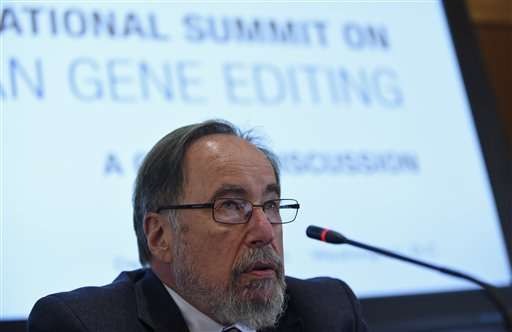No designer babies, but summit calls for cautious research

A tool to edit human genes is nowhere near ready to use for pregnancy—but altering early embryos as part of careful laboratory research should be allowed as scientists and society continue to grapple with the ethical questions surrounding this revolutionary technology, organizers of an international summit concluded Thursday.
"It would be irresponsible" to edit human sperm, eggs or early embryos in a way that leads to pregnancy, said Nobel laureate David Baltimore of the California Institute of Technology, who chaired the summit.
Tools to precisely edit genes inside living cells, especially a cheap and easy-to-use one called CRISP-Cas9, are transforming biology—and potential treatments created by them promise to do such things as cure sickle-cell anemia or fight HIV and cancer.
But depending on how it's used, it also could alter human heredity—maybe create "designer babies"—raising ethical questions that triggered three days of debate by scientists, policymakers and ethicists from 20 countries. This so-called germline editing—manipulating sperm, eggs or early embryos—wouldn't affect just one sick person but his or her descendants.
The question gained urgency after Chinese researchers made the first attempt to alter genes in human embryos, an experiment that showed scientists don't yet know how to do that safely and effectively.
The summit's organizers endorsed treatment-related gene editing research, and said lab research on germline issues "is clearly needed and should proceed" with appropriate oversight as international debate continues.
The panel offered what geneticist Eric Lander of the Broad Institute of MIT and Harvard called "a framework for deciding if and when" the reproductive use of gene editing ever moves forward.
"As scientific knowledge advances and societal views evolve, the clinical use of germline editing should be revisited on a regular basis," the committee concluded. It urged the sponsors of this week's summit—the scientific academies of the U.S., Britain and China—to create an international forum to help "establish norms concerning acceptable uses of human germline editing."
Here are some takeaways from the high-profile summit:
REAL-WORLD USE OF ANY KIND IS YEARS AWAY
First-step testing of an initial gene editing therapy has begun in people.
Sangamo Biosciences is developing an HIV treatment—pulling immune cells from patients' blood, editing a gene that boosts resistance to the virus, and returning those cells. So far, 80 HIV patients have received the therapy in first-stage testing, with good results so far, said Sangamo senior scientist Fyodor Urnov.
Next year, Sangamo plans a clinical trial that takes a next step and injects a gene editing tool directly into the body, an attempt to target hemophilia B, a blood disorder.
"We're at the beginning of this story now," cautioned Dr. Adrian Thrasher of University College London, where researchers recently treated a 1-year-old leukemia patient with edited immune cells. "What we'll see over the next five years or so is increasing clinical trials."
SCIENTIFIC QUESTIONS ABOUT EDITING HUMAN EMBRYOS
The Chinese attempt used embryos too abnormal to ever have developed into a fetus. The researchers aimed to correct a gene defect that triggers a deadly disease, but only a few embryos were fully corrected and others had alterations in the wrong spots.
But it may be feasible to gene edit sperm-producing cells that in some men don't do their job, something a University of Pittsburgh researcher is exploring.
IT'S NOT TOO EARLY TO DEBATE THE ETHICS
Every day, scientists use gene editing to create animals in the laboratory—they've bred mice, pigs, even monkeys. That means it's technically feasible for humans, too, if scientists learn the necessary steps.
One worry is about fraud—someone promising would-be parents that they could edit embryos before science actually gets there. After all, clinics that promise stem cell "therapy" that's really just snake oil already lure desperately sick people.
"The conversation is important now to try and deter people from doing it prematurely," said developmental geneticist Robin Lovell-Badge of Britain's Francis Crick Institute.
ETHICAL ARGUMENTS
Critics say changing human inheritance could have consequences not foreseeable for several generations, and would pass genetic alterations to future generations without their consent. A mistake could have irreversible consequences.
"It's a radical rupture with past human practices," said Marcy Darnovsky of the Center for Genetics and Society.
Then there's the question of what is permissible to alter: Just deleting a gene that causes a devastating disease in a family? Or enhancing future children to be smarter, prettier or more athletic? The latter triggers fear of eugenics.
"I'm skeptical about the 'Brave New World' scenario," said Dr. George Daley of Boston Children's Hospital, noting those enhancements involve more genes than anyone can guess.
But parent demand will drive research to one day end certain inherited diseases in families, Daley said, even though the number that could qualify are very rare.
"We're living in an age when humans have modified just about all aspects of our environment, deliberately or accidentally," Lovell-Badge told the summit. "In this context, it seems worth asking why would we not also want to modify ourselves?"
GLOBAL IMPACT
Other countries are having the same debate about whether to allow germline editing research—but if treatment-related gene editing eventually pans out, another question is how poor countries will afford it.
"Even if gene editing becomes a useful strategy for HIV cure, the cost may make access to such treatments impossible for people living in low-resource countries," said Keymanthri Moodley of Stellenbosch University in South Africa.
© 2015 The Associated Press. All rights reserved.




















